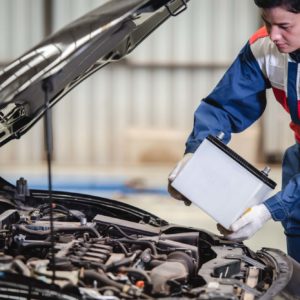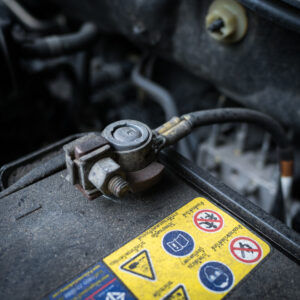There are a few ways to jump-start a dead battery on a vehicle, and that involves hooking it up to a booster battery from a different car. Some also prefer using a jump box or pack.
The process is pretty straightforward, but depending on the driver, there might be some additional steps involved.
You may have heard of other people recommending that you rev the donor car when jump-starting another vehicle. But does this practice really help or is it just another myth?
Should You Rev a Car When Jump-Starting Another Vehicle?
According to experts, revving the engine while charging the battery of another vehicle doesn’t make that much of a difference.
Revving the engine will only increase the voltage by a few hundredths, which isn’t enough to revive a dead battery.
So what can you do to help charge a battery faster? Some drivers say that it’s better to simply leave a dead battery plugged in for a few minutes to let it charge if the vehicle doesn’t back up right away.
More About Engine Revving

Revving the engine of the donor vehicle won’t exactly speed up a dead battery’s charging time, but here are some insights as to what it does.
Revving essentially increases your engine’s revolutions per minute (RPM), which you’ll see from the tachometer.
Aside from the noise that it makes, revving will also pressurize the fluids that run through the engine, lubricating metal parts in the process. A well-lubricated engine results in proper shifting.
However, it should be noted that revving the engine can have its drawbacks.
Revving without giving your vehicle enough time to warm up can put too much stress on the engine, leading to premature wear and tear of some parts.
The oil will also be cold and won’t be able to flow properly if you rev the engine without a proper warm-up.
Lastly, revving the engine reduces your vehicle’s fuel economy. You’re essentially pushing the pedal to the metal whenever you rev the engine, making it work harder without actually moving.
The Right Way to Jump-Start Your Car
Jump-starting a dead battery is an essential skill every driver must know. Even the most prepared drivers can find themselves stuck in a parking lot because of a dead battery and doing this may be the only way to get home.
Giving a vehicle a jump start is a rather simple process, and this short guide will walk you through it.
The Essentials
Always make sure to have a set of working jumper cables in your trunk. Other than that, the only thing left for you to do is to ask someone if they could help you out by using their vehicle to charge your battery.

Step 1: Positioning
Park the working vehicle as close as you can to the vehicle with a discharged battery while making sure that the two vehicles don’t touch. Side-to-side or bumper-to-bumper are common setups for a jump start.
The jumper cables should be able to reach both batteries. Once you’re done parking, turn off the ignition on both cars.
Step 2: Attaching the Cables
Once you pop both hoods, you should be able to locate the positive and negative battery terminals on the two vehicles. If you can’t see them right away, make sure to check the corresponding manual to find out the exact location.
Check the terminals for any sign of corrosion. If you happen to spot a white or greenish substance from one or more terminals, use a wire brush or aluminum foil to remove it.
You’ll find two pairs of spring-loaded clamps on your cables, each with a black and red color. The red clamps are for the positive terminals while the black ones are for the negative terminals.
Attach a red clamp to the positive terminal of the dead battery first. Then, attach the second red clamp to the booster battery’s positive terminal.
Proceed with attaching the black clamp to the negative terminal of the booster battery.
Lastly, attach the second black clamp or the negative battery terminal to the vehicle with the dead battery, preferably on an unpainted metal part of the engine like a bolt or bracket.
On some vehicles, there will be a grounding bolt marked with a negative sign.
Step 3: Jump-Starting the Vehicle
Take one last look at the jumper cables on both vehicles and make sure no clamp is touching any other part.
Start the engine with the booster battery first followed by the one with the dead battery. If the vehicle with a dead battery doesn’t start right away, wait for a few minutes before trying again.
Step 4: Disconnecting the Jumper Cables
If you’re able to successfully jump-start the dead battery and the engine’s running at a smooth idle, it’s time to remove the cables.
First, disconnect the black negative clamp from the jumped car followed by the black clamp from the booster car.
Then, remove the red clamp from the booster car followed by the red clamp from the jumped car.
From there, it’s recommended to drive the jumped car for at least 20 minutes to allow the alternator to charge the battery properly.
Get to Know Your Battery
Most automotive batteries last anywhere between three and seven years, but some practices can reduce their lifespan.
Overcharging is the leading cause of premature battery wear. Charging voltages higher than 15.5 volts can warp the battery plates due to heat and cause the battery’s active plate material to disintegrate.
Loose hold-downs can also lead to premature battery wear. Similar to overcharging, excessive vibration can lead to the plate material’s rapid disintegration.
To get the most out of your battery, always make sure that its case is clean. Also, check for any looseness around the fasteners and signs of contamination on the cables.
In case the battery cables have gotten dirty or rusty, clean them using a mixture of distilled water and baking soda.
Find a Reliable Jump Starter
Always keep a jump starter in your vehicle in case the car battery dies. A jump start lets you get your car or truck home or to a trusted repair shop to repair or replace the failed part. For a jump starter you can rely on, look no further than CarParts.com.
Make CarParts.com your one-stop shop for automotive parts, accessories, and tools like jump starters. We believe you deserve to get long-lasting products that deliver world-class performance, so we exclusively source our jump starters from companies trusted by drivers across the US. We also make finding a jump starter that fits your vehicle easy. Plug your vehicle’s details into our website’s built-in vehicle selector and browse the results. Placing an order for a jump starter takes only several taps on your phone’s screen, saving you time and energy.
Order now from CarParts.com and enjoy fast delivery to your doorstep. Choose one of our jump starters today and get it in as fast as two business days if you live in the continental US and order before noon ET.
Any information provided on this Website is for informational purposes only and is not intended to replace consultation with a professional mechanic. The accuracy and timeliness of the information may change from the time of publication.

































